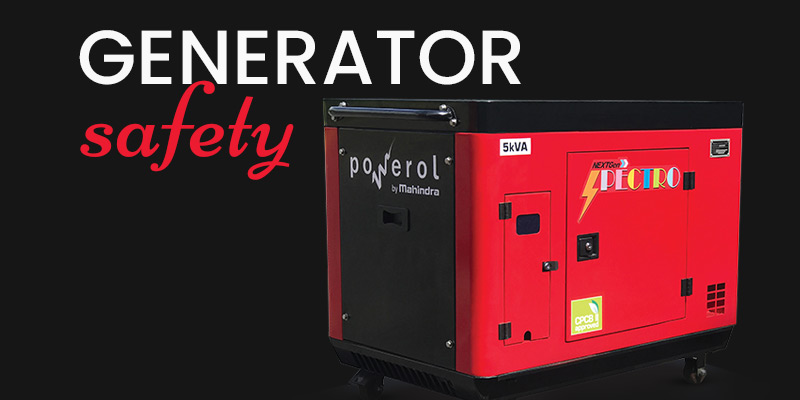A generator is a device that uses diesel or CNG to run. It does not only generate electricity but produces a lot of heat and releases dangerous gases like colorless carbon monoxide into the environment. So it is important to know about the important things while running genset.
Generators are one of the smartest investments you can make, whether you are a homeowner or running a business, or both. The backup device can keep your home or business lit through a blackout or an emergency. It helps to run multiple electric appliances constantly until the Grid Power is not coming.
How to Run a Generator Safely: Safety Checklist
1. Never Run Generators Indoors
It is strongly recommended to operate a generator outside the building. The reason behind is the generators produce carbon monoxide, a colorless and even odorless gas that can lead to death. You can also feel a shortage of breath, headache, stomach pain, and other health problems if you run genset inside.
What’s the solution?
- Prepare a proper and well-ventilated shade. It helps to keep the genset switched on and working while in the rain and also protects it from all kinds of weather.
- Place the exhaust pipe outside the house (if you have your genset inside the house) so the produced gases don’t harm you.
- Try to keep the genset 20 feet away from the house.
- Install Smoke Detectors for better safety.
Also Read: Generator Buyer’s Guide – How to Pick the Perfect Generator
2. Know About the Load
It is one of the top priorities when choosing generators for home or industry. If you don’t do so, then you are at the risk of overloading. Overloads occur when you have too many appliances plugged in, and it exceeds the total running watts that the machine can support.
Overloading generators is extremely dangerous because it can lead to overheating as a result it damages your all plugged items and can lead to fire. It also exhausts your fuel. The circuit breaker can shut down or break down your power in case of overloading, but it is not guaranteed.
To avoid the overloading situation, buy a genset according to your wattage. If you are unaware of how to calculate the load, then it is advisable to consult the electrician.
3. Buy a Generator Based on Your Load
Calculate the proper load before buying the genset. You can also consult with an electrician to know about the load or even you can calculate your load through online platforms.
The following table shows the wattage of appliances
| Appliances | Average Wattage |
| Ceiling Fan | 75W |
| Room Cooler | 250W |
| laptop | 100W |
| CFL Light Bulb | 5W, 9W, 15W, 30W |
| Tube Light | 20W, 40W |
| Light Bulb | 40W, 60W, 100W |
| LED TV(upto 40 inch) | 60W |
| Music System | 300W |
| AC(Air Conditioner) | 1500W |
| Refrigerator | 300W |
| Microwave | 1500W |
| Washing Machine | 1000W |
| Geyser | 2200W |
| Juicer Mixer Grinder | 800W |
| Water Pump | 800W |
| Wall Socket | 60W |
| Power Socket | 1000W |
This is the average load of appliances that are regularly used in houses as well as factories.
How to Calculate the Load of a Single Room
| Appliances | Average Wattage | Quantity | Total Wattage |
| Ceiling Fan | 75W | 1 | 75W |
| LED Light | 15W | 2 | 30W |
| TubeLight | 20W | 1 | 20W |
| Air Conditioner | 1500W | 1 | 1500W |
| Wall Socket(Running) | 60W | 4 | 240W |
| Total Load | 1865W |
4. Install Transfer Switch or Circuit Beaker
Always install a circuit breaker right next to the extension cords between the generator and your house for a buffer. It provides extra safety to your appliances.
Transfer switches can be manual or automatic. It also helps break down the circuit in the overloading state or short circuit.
5. Using Appropriate Wire
Based on your load install the appropriate wire. If you are using portable generators, then always make sure that the wire is in the right state or you can also change it after some time for extra safety. Instead of using loose wire, use insulated heavy-duty wire from generators to home.
6. Fuel Stock up
Always stock up the fuel, it will help you in case of emergencies such as floods, tornados, etc. It is very difficult to restart the generators once the fuel tank is empty.
7. Shut Down the Genset Before Refueling
Don’t refuel the generator when it is running as it can lead to serval dangerous hazards. In some cases, it can cause fire or even explosion. It is advisable to refill the oil tank before starting the generators, or turn off the generator and let it cool down and then refill it after 30-45 minutes.
8. Store Your Genset Properly
Build a proper structure to store the generator, fuel, and transfer switch. Always place your fuel separately from the generator.
9. Install Proper Ground Earthing
Ground Earthing can minimize the possibility of uncommon current flow resulting in a power outage, damage to equipment, and/or injuries to personnel. Always use copper wire for earthing.
Final Thoughts
Like Grid Power, there are serval hazards with generators. However proper information can prevent these hazards. Always follow the instructions or keep a proper checklist while switching on or off the generator.
SOL Power Solutions is an authorized dealer of Mahindra Powerol in Mohali, offering all Kind of generators for your needs. They also deliver to nearby areas like Chandigarh, Kharar, Ropar, Kurali, and Patiala. Contact us now.





